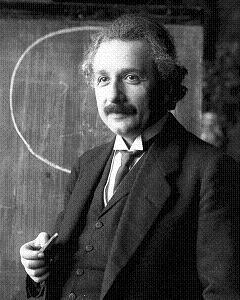
Matthew Leitch, educator, consultant, researcher
Real Economics and sustainability
Psychology and science generally
OTHER MATERIALWorking In Uncertainty
Albert Einstein's theory of special relativity
‘Albert Einstein’ you're probably thinking, ‘well, obviously.’ Einstein is so famous for putting forward ideas that at first seem strange and contrary to all established wisdom and everyday common sense that he has become a hero of maveric thinking. Here is someone who famously challenged something thought to be correct (Newton's laws of motion) and showed them to be wrong.
Einstein himself made many statements about the difficulty and value of escaping from what people generally think is true. For example, he is credited with these (among many others):
‘Common sense is the collection of prejudices acquired by age eighteen.’
‘Few people are capable of expressing with equanimity opinions which differ from the prejudices of their social environment. Most people are even incapable of forming such opinions.’
But how did he do it? Well, not by just having wild thoughts. Einstein reasoned his way to conclusions that seemed bizarre. In the case of special relativity, Einstein had noticed that Newton's laws of motion were logically inconsistent with Maxwell's laws of electromagnetism. Newton's laws had been developed to describe things moving at ordinary speeds, while Maxwell's laws had been tested against things moving at light speeds. They were inconsistent so one or both had to be wrong.

Einstein laboured with this problem, on and off, for years. A few hours before he made his breakthrough he said he had failed. However, with the aid of some lucky prompts and his years of work on the problem, he saw that one possible answer that would work was that time and space could be different at different places in the universe. This would be in such a way that the differences were noticeable at light speeds but tiny at ordinary speeds, which would explain why it hadn't been noticed by Newton and everyone else using his equations.
In all his work on this problem it is reasonable to expect that Einstein thought about every variable in the equations of Newton and Maxwell, looking to ways to resolve the conflict. He must have spent a long time studying and eventually discarding many possibilities that at first seemed more likely. In the end, the idea that the variable for time might be the place to make a change must have seemed quite reasonable and Einstein would have known a lot about what his solution would have to look like to work.
If Sherlock Holmes had been a real person he would probably have nodded knowingly and said something like:
‘...when you have eliminated the impossible, whatever remains, however improbable, must be the truth.’
| Working In Uncertainty observations |
Einstein's insight into special relativity is an example of an unusually important discovery made possible by being able to push past a generally held view that in fact was wrong. His method of doing this – by working very hard and making inferences that propelled his thinking into new areas – is an effective approach in everyday situations as well as in physics. |
|---|
Made in England